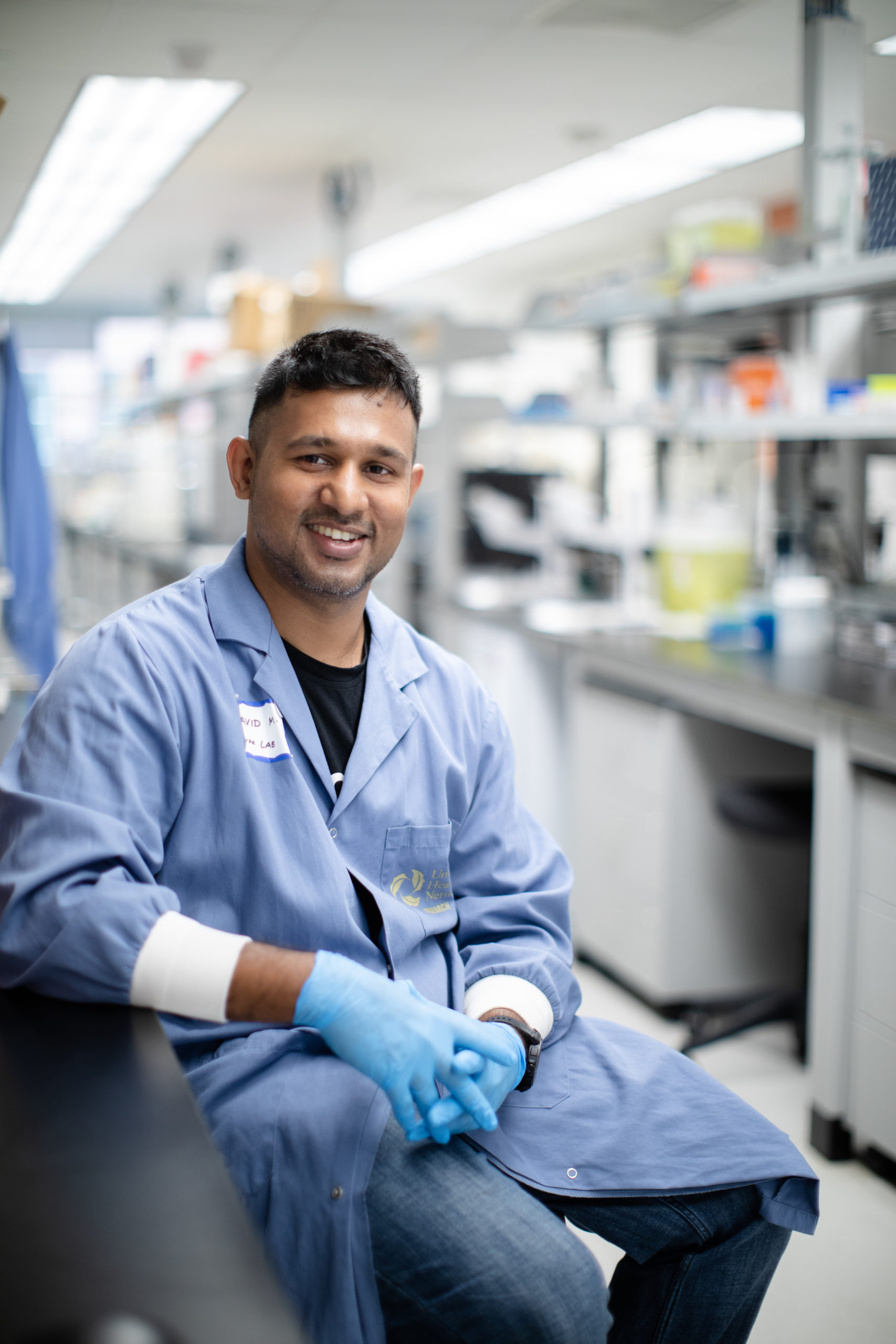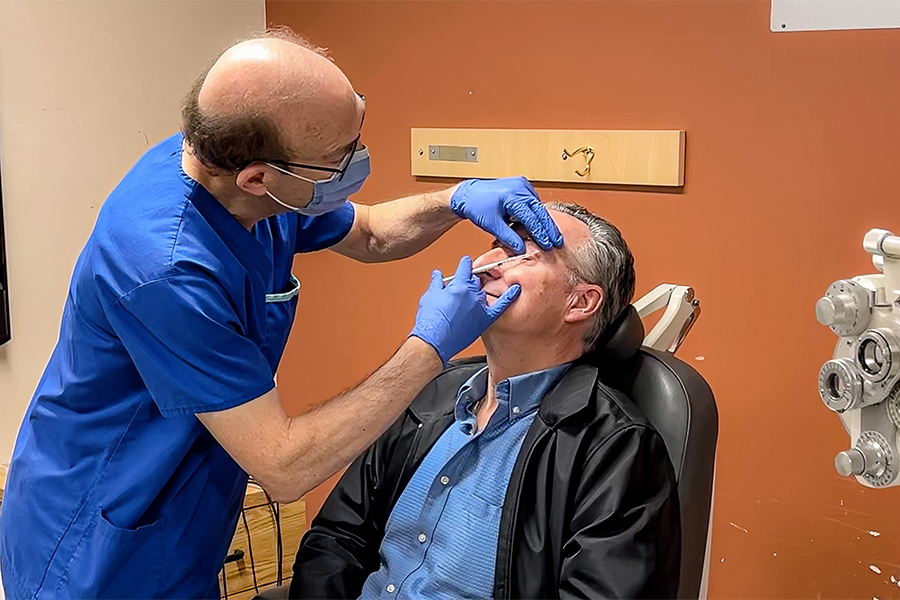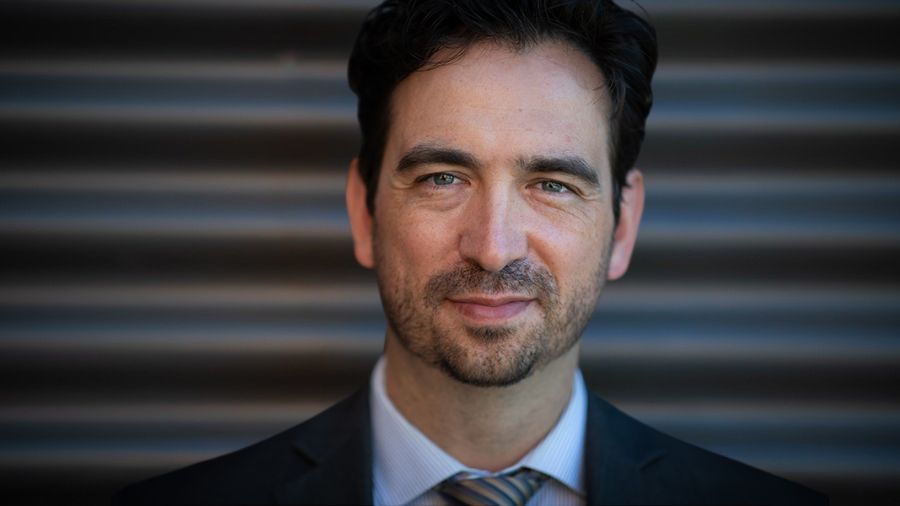Molecules that protect. Dr. Jeremy Sivak calls neuroprotection an “ultimate goal for glaucoma treatment.” Photos: Tim Fraser.
By Mirjam Guesgen
When scientist Dr. Jeremy Sivak describes how delicate the optic nerve is, he points to a foam model of the eye that he uses for teaching. The place where the thin thread of foam representing the optic nerve should be is now damaged and torn – worn away by bringing the model out during lectures.
“It’s easy to see how it’s a mechanically weak spot,” says Dr. Sivak, who is a senior scientist at the Donald K. Johnson Eye Institute.
That collection of fibres may be tenuous, but it’s also crucial to our vision. The optic nerve sends information collected by our eyes to the brain to be translated into sight. Optic nerve damage – a key characteristic of the eye disease glaucoma – can cause blindness when the connection between information gatherer and interpreter is disrupted.
It’s estimated that more than 400,000 Canadians live with glaucoma. That number may be much higher, since the disease comes on slowly, and people may not realize they have it until major damage has already been done.
But because the disease progresses slowly for most patients, there is a chance for doctors to stop it in its tracks. Neuroprotection, or shielding the optic nerve from damage, offers a way to do just that.
Dr. Sivak and his team, along with collaborators, have discovered a molecule that could protect the delicate optic nerve, thus sparing people from gruelling surgeries or, in the worst-case scenario, a life without sight.
“Neuroprotection is kind of an ultimate goal for glaucoma treatment,” says Dr. Sivak, who also holds the Chair in Glaucoma Research at UHN.
In addition to preventing the disease from getting worse, it might even be possible to reverse the damage that’s been done, says Donald K. Johnson Eye Institute clinical fellow Dr. David Mathew, who’s researching neuroprotection with Dr. Sivak.
“Right now, we have no proven way to definitively reverse the damage. All treatments are aimed at stopping or slowing down the disease progression,” he says. “That would be a big boon to our patients.”
Dr. Sivak’s team is studying lipoxins – molecules that in other contexts help reduce inflammation brought on by injury. Other researchers have studied what lipoxins do in various places in the body, but never before in nerve cells of the brain or eye. Dr. Sivak’s group found that these molecules play a very different role in brain cells, directly protecting neurons from damage.
78 MILLION PEOPLE ARE LIVING WITH GLAUCOMA WORLDWIDE
The team made the discovery when they noticed that in diseased eyes, the naturally occurring amount of lipoxins (called LXA4 and LXB4) was lower than in healthy eyes. But when the team restored lipoxin levels, they restored the molecules’ protective function so they could rescue the neurons from further damage.
Potential therapies could include stimulating the body to make more lipoxins, or delivering the molecules by injection to where they’re needed.
“What has become an important quest for us is to map how LXA4 and LXB4 work and what makes them so effective as neuroprotective factors,” says Dr. Sivak. “If we can understand that, not only is it interesting new biology, but it also may give us ways to target the pathway that might be clinically feasible.”

The work being done by Drs. Sivak and Mathew could resonate far beyond eye disease. Neuroprotection could potentially help treat or slow the progression of other diseases where related neuron damage occurs, such as Alzheimer’s or Parkinson’s.
Dr. Sivak says they’ve seen the same kind of protective activity from lipoxins on cells from parts of the brain such as the hippocampus, which is involved in the formation of new memories, and the substantia nigra, which helps co-ordinate movement.
If the link between low amounts of lipoxins and neuron loss can be proven, a lipoxin-boosting treatment for glaucoma could eventually be tailored to treat neurodegenerative diseases. “We’re very interested in trying to pioneer that field,” says Dr. Sivak.
While the possibility of breakthroughs in the neurodegenerative realm is undoubtedly exciting, Drs. Sivak and Mathew say that their first goal is to find a solution for those with glaucoma.
“Vision is so important to our quality of life and increasingly so in our virtually connected world,” says Dr. Sivak.
Dr. Mathew hopes the pair can work together to bring their findings from the lab to their patients, and the millions of people struggling with glaucoma around the world. “I have seen a lot of patients eventually go blind from glaucoma, so I know first-hand how valuable a neuroprotective strategy would be,” he says.
This article originally appeared in the magazine Vision: A look inside the Donald K. Johnson Eye Institute.


